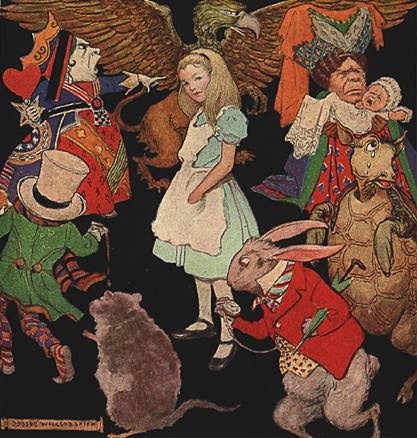Alice on the Web
by Grace Raffaele and Meryl Meisler

|
Alice on the Web by Grace Raffaele and Meryl Meisler |
 |
As students read "Alice’s Adventures in Wonderland” (http://sabian.org/alice.htm ) and “Through the Looking Glass” and “What Alice Saw There” (http://sabian.org/Alice/lgchap01.htm ) by Lewis Carroll (http://victorianweb.org/authors/carroll/carrollov.html ), they accumulate written responses and creative writing pieces which will later become part of their own individual “Alice Books.”
Students read the books (http://sabian.org/alice.htm )and do the written assignments as part of their Humanities course. Chapters are sometimes read aloud in class and sometimes assigned for homework. There is always a written component to the homework and some written responses are done in class as well. These assignments focus less on retelling of events and more on personal and creative responses.
The main written response format is in what we call a “double-entry.” Students fold a page in their notebook in half. As they read, they look for 2 quotes that they find interesting or that make them think about themselves or that help them to make real-world connections. On the left hand side of their page, they write at least 2 quotes (correctly punctuated) and on the right hand side they write their reason for choosing each quote and what it made them think about. The total responses on the right hand side must reach the bottom of the page. We do one double-entry response for each chapter, either for homework or as class work.
On several occasions, students are told to draw or copy John Tenniel’s (http://victorianweb.org/art/illustration/tenniel/pva65.html ) illustrations instead of using a quote on the left hand side and to respond on the right hand side to the action shown n the drawing. Discussion following these drawing assignments focus on whether the author gives visual clues and, if not, how does an illustrator work with an author’s text? How much is the author’s and how much is the illustrator’s?
The other written responses that are requested are intended to engage the students in creative and imaginative writing. In-class discussions center around the author’s sense of humor and his criticism of Victorian manners (http://killeenroos.com/4/manners.htm ). However, students are also encouraged, through the writing assignments, to use their own imagination and apply some of the techniques of satire, puns and parody to create their own episodes. Assignments include:
The Arts Component
Students create their own accordion ( http://kid-at-art.com/htdoc/lesson25.html )“Alice Books” in their art class using the written responses and creative writing from the Humanities class. The students' “Alice Books” are digitally photographed and archived on the WWW.
Extension Activities:
In addition to the books, students create one other visual representation of their experience with the reading. They will present these to the class. They may choose one of the following:
Create a diorama that shows one of the scenes in either book.
Create a sculpture or 3-D representation of one of the characters.
Work together with 1 or 2 classmates to resent a scene with costumes and scenery.
Try making a variety of handmade books such as:
single stitch book- http://dickblick.com/lessonplans/handmadebooks/
paper bag book- http://arts.ufl.edu/art/rt_room/sparkers/artist_book/make_a_book.html
Developed by Meryl Meisler and Grace Raffaele for TeachNet 2005